Probabilistic Intraday PV Power Forecast Using Ensembles of Deep Gaussian Mixture Density Networks
Abstract
1. Introduction
1.1. Motivation and Background
1.2. Aleatoric and Epistemic Uncertainty
1.3. Probabilistic Forecasts
1.4. Contributions and Scope
- Analyzing the probabilistic forecast quality of MDN PV power forecasts and extending them with different approaches to encompass the epistemic uncertainty;
- Examining the influence of different architectural configurations (e.g., number of mixture components/distributions and ensemble members);
- Assessing the significance of the different uncertainty types for industrial applications by varying the number of available past data for training and validation (7 and 182 days/half a year);
1.5. Organization
2. Data
3. Methodology
3.1. Mixture Density Networks
3.2. Epistemic Extension of Mixture Density Networks
3.3. Training and Network Parameter
4. Evaluation Framework
| Algorithm 1: Complete-history persistence ensemble |
|
5. Results
5.1. Influence of Training Data and Mixture Distributions
5.2. Benefit of Epistemic Estimation in MDNs
6. Conclusions and Outlook
- By using multiple Gaussian distributions in a mixture model, the uncertainty distribution can be estimated more accurately. For example, when using ten Gaussian distributions instead of one, the NCRPS on average increases by 30.5% for a one step ahead prediction and by 20.5% averaged for the predictions over six hours. Consequently, the MDN can be seen as an improvement to a deep ensemble reference forecast with only one Gaussian output distribution;
- MDN forecasts achieve relatively good results even with a limited amount of training data. Already with 7 days, the MDN was 23.9% better than the CH-PeEn benchmark;
- Epistemic uncertainty has a major impact of up to 19.5% on the overall accuracy of MDN forecasts, especially when the amount of training data are limited. Therefore, compensation methods should always be considered in practice;
- Already a few ensemble members are capable of achieving significant forecast improvements. For example, five model initialization may result in a quality increase of up to 15.72%;
- Ensemble members generated by model initialization in combination with training data sampling improved the forecast quality relatively up to 83% more than ensemble members generated by MC dropout.
Author Contributions
Funding
Data Availability Statement
Acknowledgments
Conflicts of Interest
Abbreviations
| CDF | Cumulative distribution function |
| CRPS | Continuous ranked probability score |
| CH-PeEn | Complete-history persistence ensemble |
| GHI | Global horizontal irradiance |
| GMM | Gaussian mixture model |
| MC | Monte Carlo |
| MDN | Mixture density networks |
| NCRPS | Normalized continuous ranked probability score |
| NWP | Numerical weather prediction |
| MSE | Mean squared error |
| PV | Photovoltaics |
| SS | Skill score |
| VRE | Variable renewable energy |
References
- Hong, T.; Pinson, P.; Fan, S.; Zareipour, H.; Troccoli, A.; Hyndman, R.J. Probabilistic energy forecasting: Global Energy Forecasting Competition 2014 and beyond. Int. J. Forecast. 2016, 32, 896–913. [Google Scholar] [CrossRef]
- Bundesnetzagentur. Genehmigung des Szenariorahmens 2023–2037/2045; Technical Report; Bundesnetzagentur: Bonn, Germany, 2022. [Google Scholar]
- European Commission. EU Solar Energy Strategy; European Commission: Brussels, Belgium, 2022. [Google Scholar]
- Dent, C.J.; Bialek, J.W.; Hobbs, B.F. Opportunity Cost Bidding by Wind Generators in Forward Markets: Analytical Results. IEEE Trans. Power Syst. 2011, 26, 1600–1608. [Google Scholar] [CrossRef]
- El-Baz, W.; Tzscheutschler, P.; Wagner, U. Day-ahead probabilistic PV generation forecast for buildings energy management systems. Sol. Energy 2018, 171, 478–490. [Google Scholar] [CrossRef]
- Gross, A.; Lenders, A.; Zech, T.; Wittwer, C.; Diehl, M. Using Probabilistic Forecasts in Stochastic Optimization. In Proceedings of the 2020 International Conference on Probabilistic Methods Applied to Power Systems (PMAPS), Liege, Belgium, 18–21 August 2020; IEEE: New York, NY, USA, 2020; pp. 1–6. [Google Scholar] [CrossRef]
- Li, B.; Zhang, J. A review on the integration of probabilistic solar forecasting in power systems. Sol. Energy 2020, 210, 68–86. [Google Scholar] [CrossRef]
- Bucksteeg, M.; Niesen, L.; Weber, C. Impacts of Dynamic Probabilistic Reserve Sizing Techniques on Reserve Requirements and System Costs. IEEE Trans. Sustain. Energy 2016, 7, 1408–1420. [Google Scholar] [CrossRef]
- Lorca, Á.; Sun, X.A. Adaptive Robust Optimization With Dynamic Uncertainty Sets for Multi-Period Economic Dispatch Under Significant Wind. IEEE Trans. Power Syst. 2015, 30, 1702–1713. [Google Scholar] [CrossRef]
- Yang, D.; Alessandrini, S.; Antonanzas, J.; Antonanzas-Torres, F.; Badescu, V.; Beyer, H.G.; Blaga, R.; Boland, J.; Bright, J.M.; Coimbra, C.F.; et al. Verification of deterministic solar forecasts. Sol. Energy 2020, 210, 20–37. [Google Scholar] [CrossRef]
- Kendall, A.; Gal, Y. What Uncertainties Do We Need in Bayesian Deep Learning for Computer Vision? In Advances in Neural Information Processing Systems; The MIT Press: Cambridge, MA, USA, 2017; pp. 5575–5585. [Google Scholar]
- Hüllermeier, E.; Waegeman, W. Aleatoric and Epistemic Uncertainty in Machine Learning: An Introduction to Concepts and Methods. arXiv 2019, arXiv:1910.09457. [Google Scholar] [CrossRef]
- Al-gabalawy, M.; Hosny, N.S.; Adly, A.R. Probabilistic forecasting for energy time series considering uncertainties based on deep learning algorithms. Electr. Power Syst. Res. 2021, 196, 107216. [Google Scholar] [CrossRef]
- Grantham, A.; Gel, Y.R.; Boland, J. Nonparametric short-term probabilistic forecasting for solar radiation. Sol. Energy 2016, 133, 465–475. [Google Scholar] [CrossRef]
- Zemouri, N.; Bouzgou, H.; Gueymard, C.A. Multimodel ensemble approach for hourly global solar irradiation forecasting. Eur. Phys. J. Plus 2019, 134, 594. [Google Scholar] [CrossRef]
- Bracale, A.; Carpinelli, G.; De Falco, P. A Probabilistic Competitive Ensemble Method for Short-Term Photovoltaic Power Forecasting. IEEE Trans. Sustain. Energy 2017, 8, 551–560. [Google Scholar] [CrossRef]
- Sperati, S.; Alessandrini, S.; Delle Monache, L. An application of the ECMWF Ensemble Prediction System for short-term solar power forecasting. Sol. Energy 2016, 133, 437–450. [Google Scholar] [CrossRef]
- Alessandrini, S.; Delle Monache, L.; Sperati, S.; Cervone, G. An analog ensemble for short-term probabilistic solar power forecast. Appl. Energy 2015, 157, 95–110. [Google Scholar] [CrossRef]
- Doelle, O.; Kalysh, I.; Amthor, A.; Ament, C. Comparison of intraday probabilistic forecasting of solar power using time series models. In Proceedings of the 2021 International Conference on Smart Energy Systems and Technologies (SEST), Vaasa, Finland, 6–8 September 2021; IEEE: New York, NY, USA, 2021; pp. 1–6. [Google Scholar] [CrossRef]
- Lauret, P.; David, M.; Pedro, H.T. Probabilistic solar forecasting using quantile regression models. Energies 2017, 10, 1591. [Google Scholar] [CrossRef]
- van der Meer, D.; Widén, J.; Munkhammar, J. Review on probabilistic forecasting of photovoltaic power production and electricity consumption. Renew. Sustain. Energy Rev. 2018, 81, 1484–1512. [Google Scholar] [CrossRef]
- Dumas, J.; Cointe, C.; Fettweis, X.; Cornelusse, B. Deep learning-based multi-output quantile forecasting of PV generation. In Proceedings of the 2021 IEEE Madrid PowerTech, Madrid, Spain, 27 June–2 July 2021; IEEE: New York, NY, USA, 2021; pp. 1–6. [Google Scholar] [CrossRef]
- David, M.; Ramahatana, F.; Trombe, P.J.; Lauret, P. Probabilistic forecasting of the solar irradiance with recursive ARMA and GARCH models. Sol. Energy 2016, 133, 55–72. [Google Scholar] [CrossRef]
- Hyndman, R.J.; Koehler, A.B.; Snyder, R.D.; Grose, S. A state space framework for automatic forecasting using exponential smoothing methods. Int. J. Forecast. 2002, 18, 439–454. [Google Scholar] [CrossRef]
- Najibi, F.; Apostolopoulou, D.; Alonso, E. Enhanced performance Gaussian process regression for probabilistic short-term solar output forecast. Int. J. Electr. Power Energy Syst. 2021, 130, 106916. [Google Scholar] [CrossRef]
- David, M.; Luis, M.A.; Lauret, P. Comparison of intraday probabilistic forecasting of solar irradiance using only endogenous data. Int. J. Forecast. 2018, 34, 529–547. [Google Scholar] [CrossRef]
- Doubleday, K.; Jascourt, S.; Kleiber, W.; Hodge, B.m. Probabilistic Solar Power Forecasting Using Bayesian Model Averaging. IEEE Trans. Sustain. Energy 2021, 12, 325–337. [Google Scholar] [CrossRef]
- Liu, R.; Wei, J.; Sun, G.; Muyeen, S.M.; Lin, S.; Li, F. A short-term probabilistic photovoltaic power prediction method based on feature selection and improved LSTM neural network. Electr. Power Syst. Res. 2022, 210, 108069. [Google Scholar] [CrossRef]
- Zhang, H.; Liu, Y.; Yan, J.; Han, S.; Li, L.; Long, Q. Improved Deep Mixture Density Network for Regional Wind Power Probabilistic Forecasting. IEEE Trans. Power Syst. 2020, 35, 2549–2560. [Google Scholar] [CrossRef]
- Bishop, C.M. Mixture Density Networks; Technical Report; Department of Computer Science and Applied Mathematics Aston University: Birmingham, UK, 1994. [Google Scholar]
- Vallejo, D.; Chaer, R. Mixture Density Networks applied to wind and photovoltaic power generation forecast. In Proceedings of the 2020 IEEE PES Transmission & Distribution Conference and Exhibition—Latin America (T & D LA), Montevideo, Uruguay, 28 September–2 October 2020; IEEE: New York, NY, USA, 2020; pp. 1–5. [Google Scholar] [CrossRef]
- Brusaferri, A.; Matteucci, M.; Spinelli, S.; Vitali, A. Probabilistic electric load forecasting through Bayesian Mixture Density Networks. Appl. Energy 2022, 309, 118341. [Google Scholar] [CrossRef]
- Gal, Y.; Ghahramani, Z. Dropout as a Bayesian Approximation: Representing Model Uncertainty in Deep Learning. In Proceedings of the 33rd International Conference on International Conference on Machine Learning, New York, NY, USA, 19–24 June 2016; Volume 48, pp. 1651–1660. [Google Scholar]
- Breiman, L. Bagging predictors. Mach. Learn. 1996, 24, 123–140. [Google Scholar] [CrossRef]
- European Commission. EB GL: Comission Regulation (EU) 2017/2195 establishing a guideline on electricity balancing. Off. J. Eur. Union 2017, 2017, 312/6–312/53. [Google Scholar]
- Lakshminarayanan, B.; Pritzel, A.; Blundell, C. Simple and Scalable Predictive Uncertainty Estimation using Deep Ensembles. In Advances in Neural Information Processing Systems; The MIT Press: Cambridge, MA, USA, 2016; pp. 6403–6414. [Google Scholar]
- Srivastava, N.; Hinton, G.; Krizhevsky, A.; Sutskever, I.; Salakhutdinov, R. Dropout: A Simple Way to Prevent Neural Networks from Overfitting. J. Mach. Learn. Res. 2014, 15, 1929–1958. [Google Scholar]
- Fort, S.; Hu, C.H.; Lakshminarayanan, B. Deep Ensembles: A Loss Landscape Perspective. arXiv 2020, arXiv:1912.02757. [Google Scholar]
- van der Meer, D. Comment on “Verification of deterministic solar forecasts”: Verification of probabilistic solar forecasts. Sol. Energy 2020, 210, 41–43. [Google Scholar] [CrossRef]
- Doubleday, K.; Van Scyoc Hernandez, V.; Hodge, B.M. Benchmark probabilistic solar forecasts: Characteristics and recommendations. Sol. Energy 2020, 206, 52–67. [Google Scholar] [CrossRef]
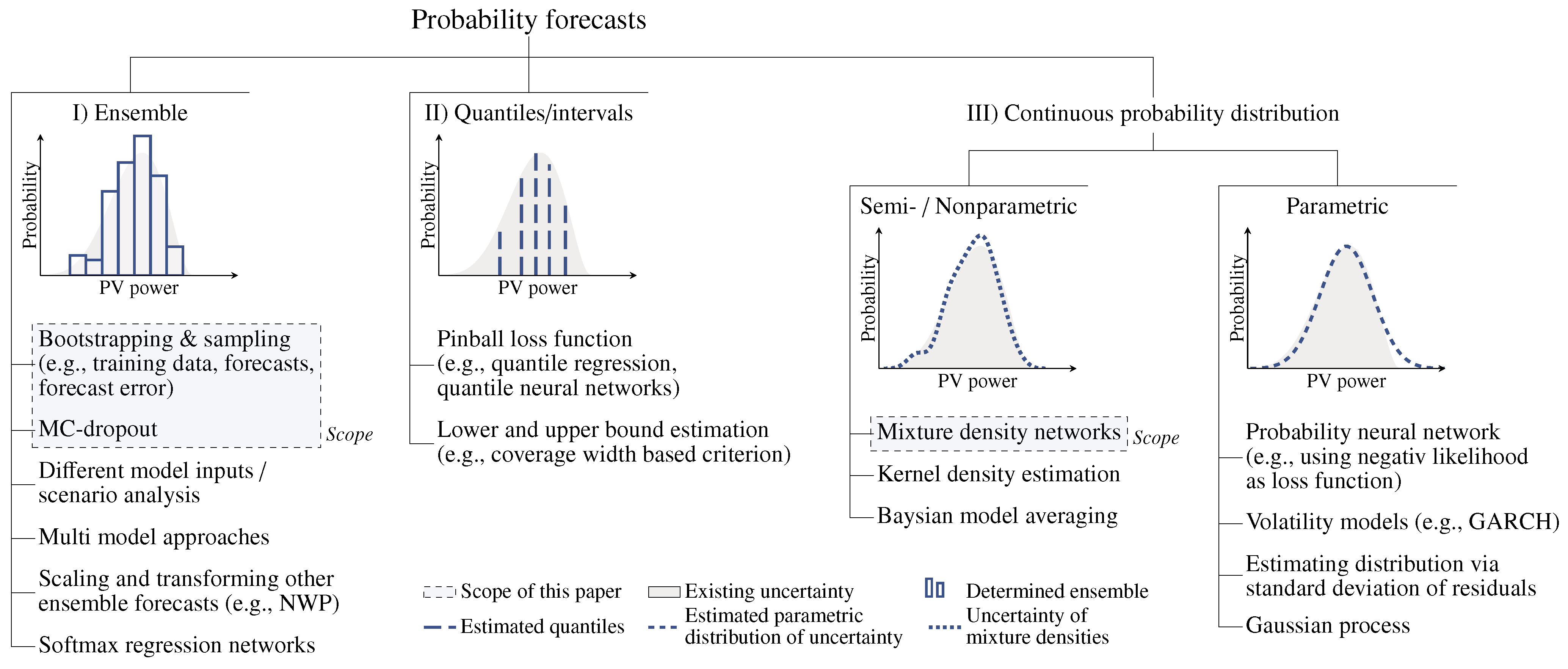
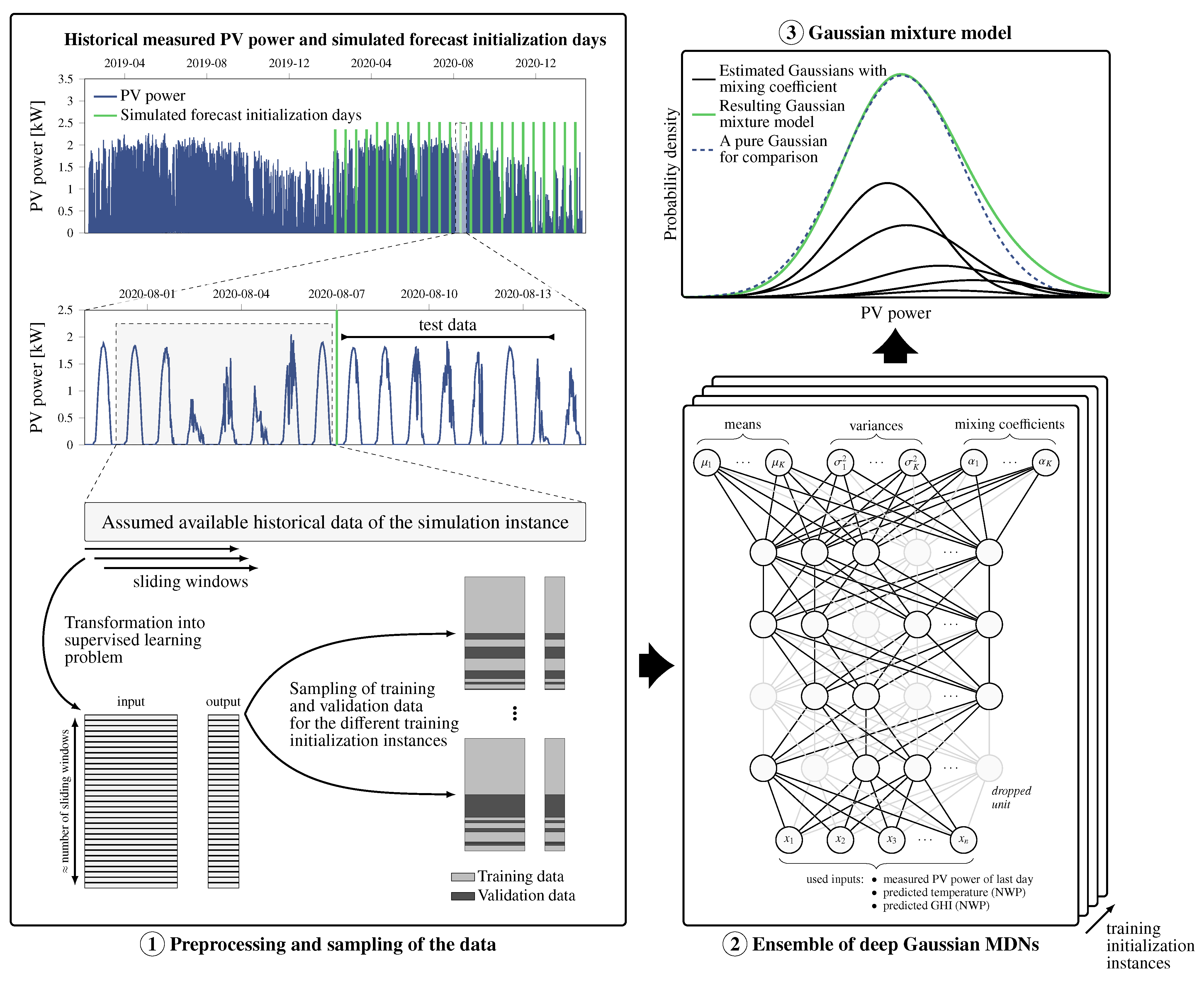
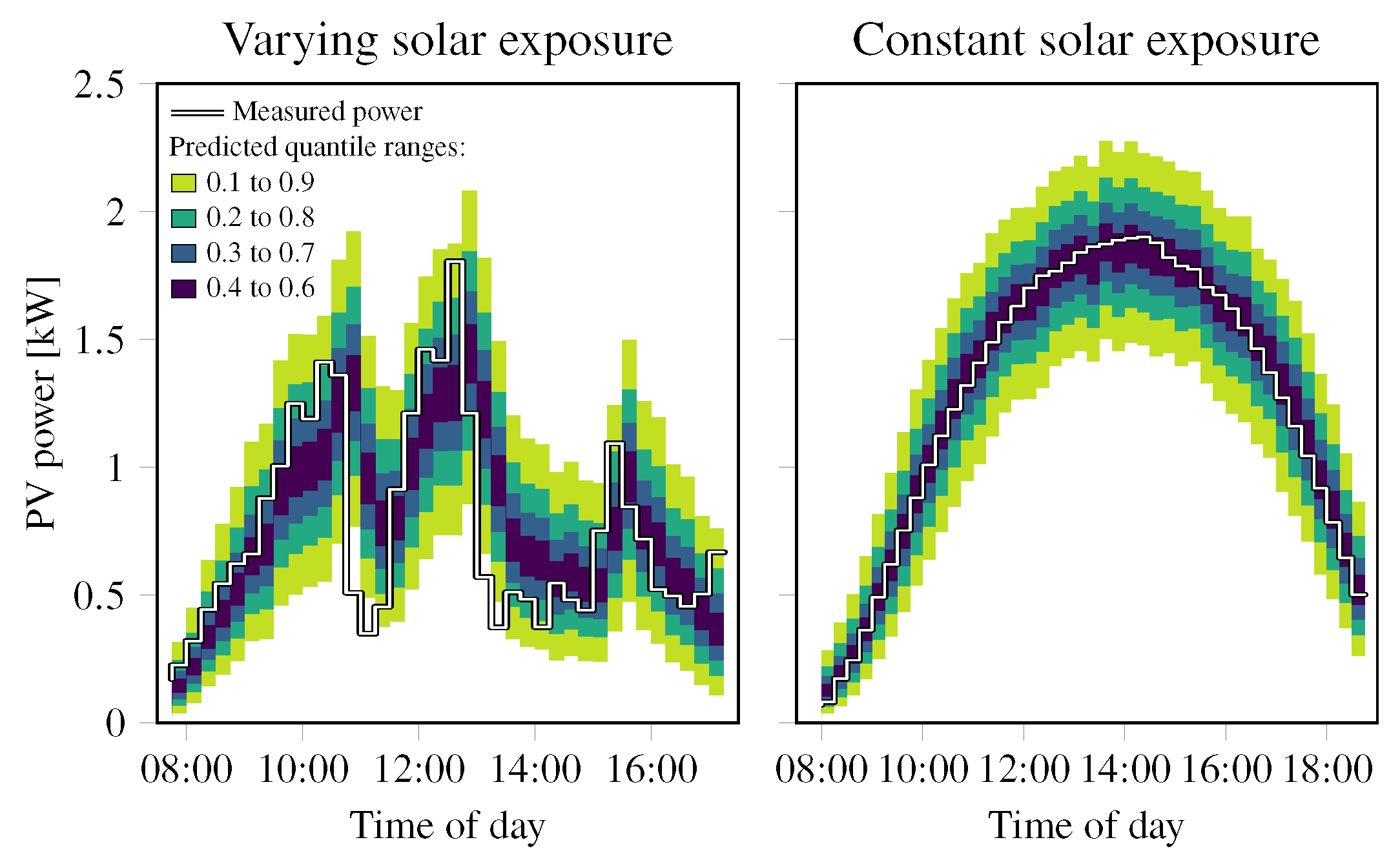
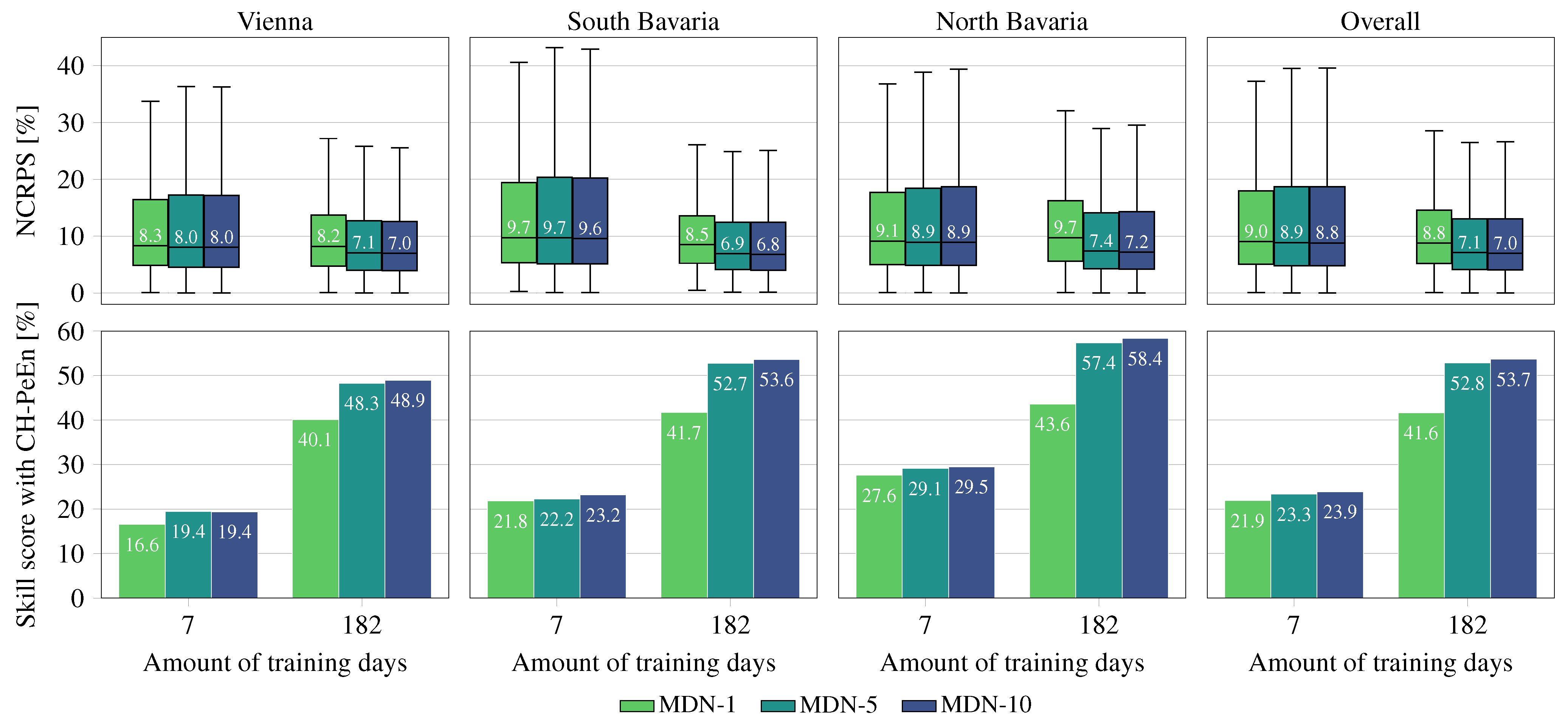
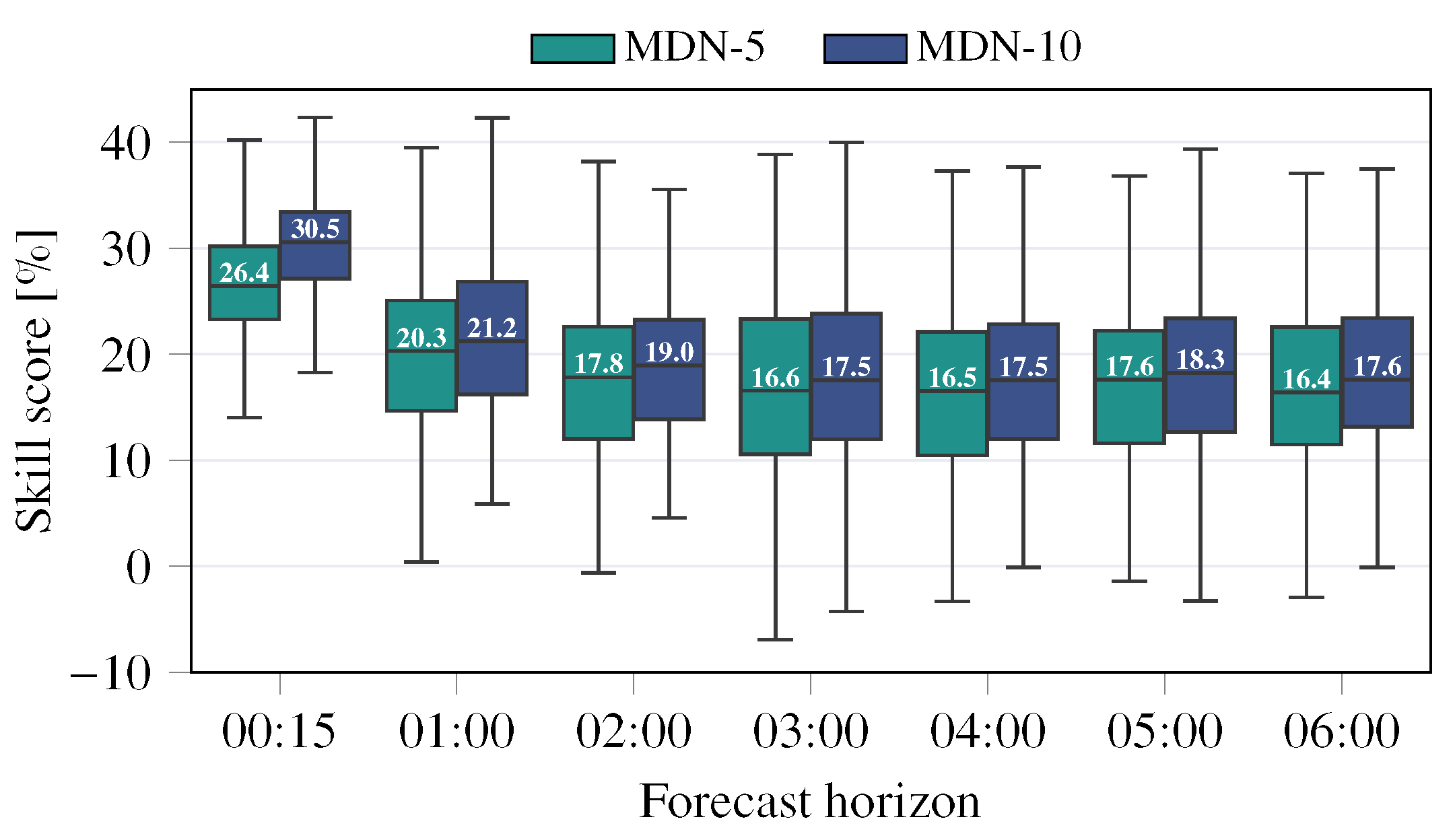

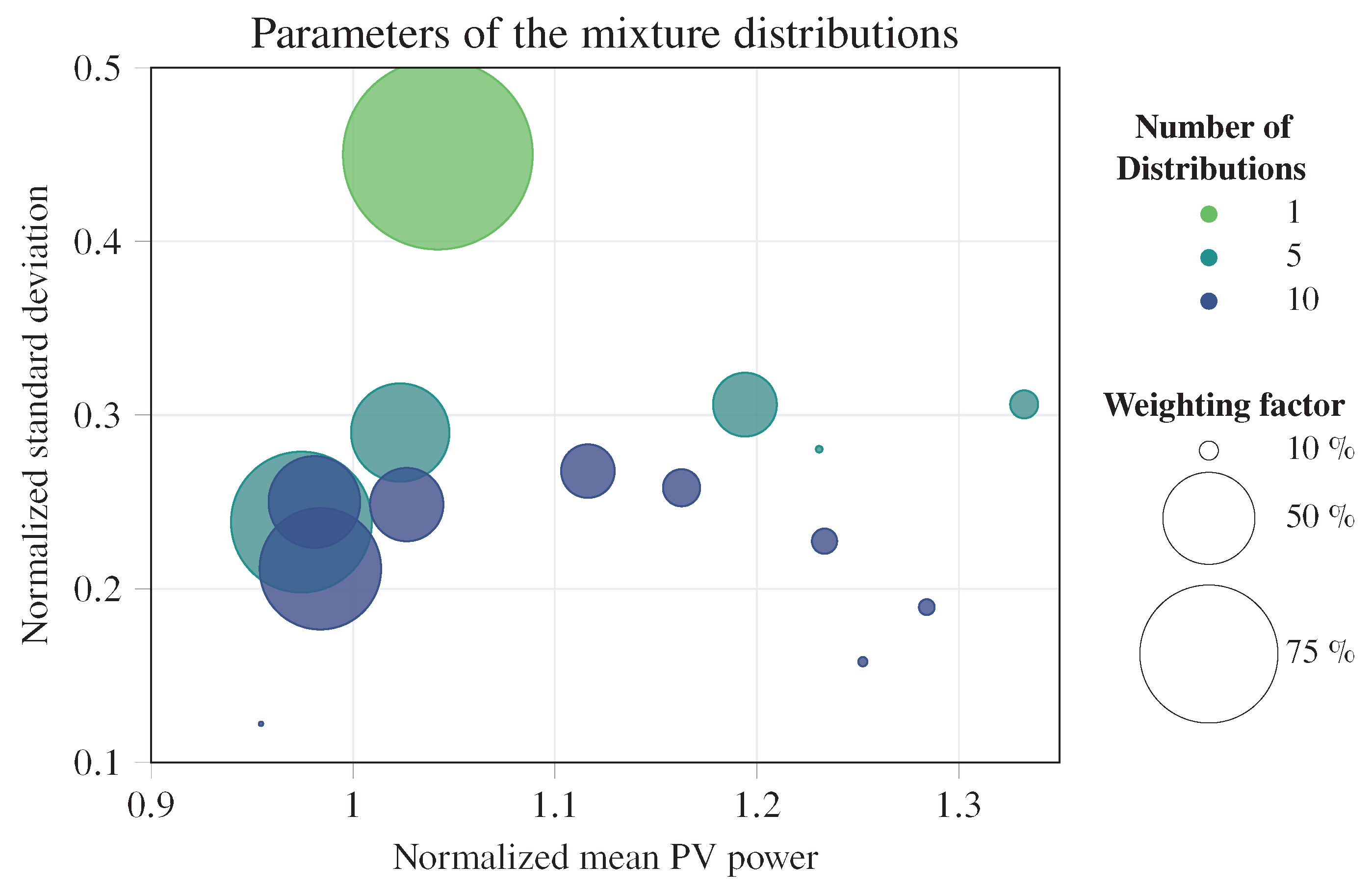
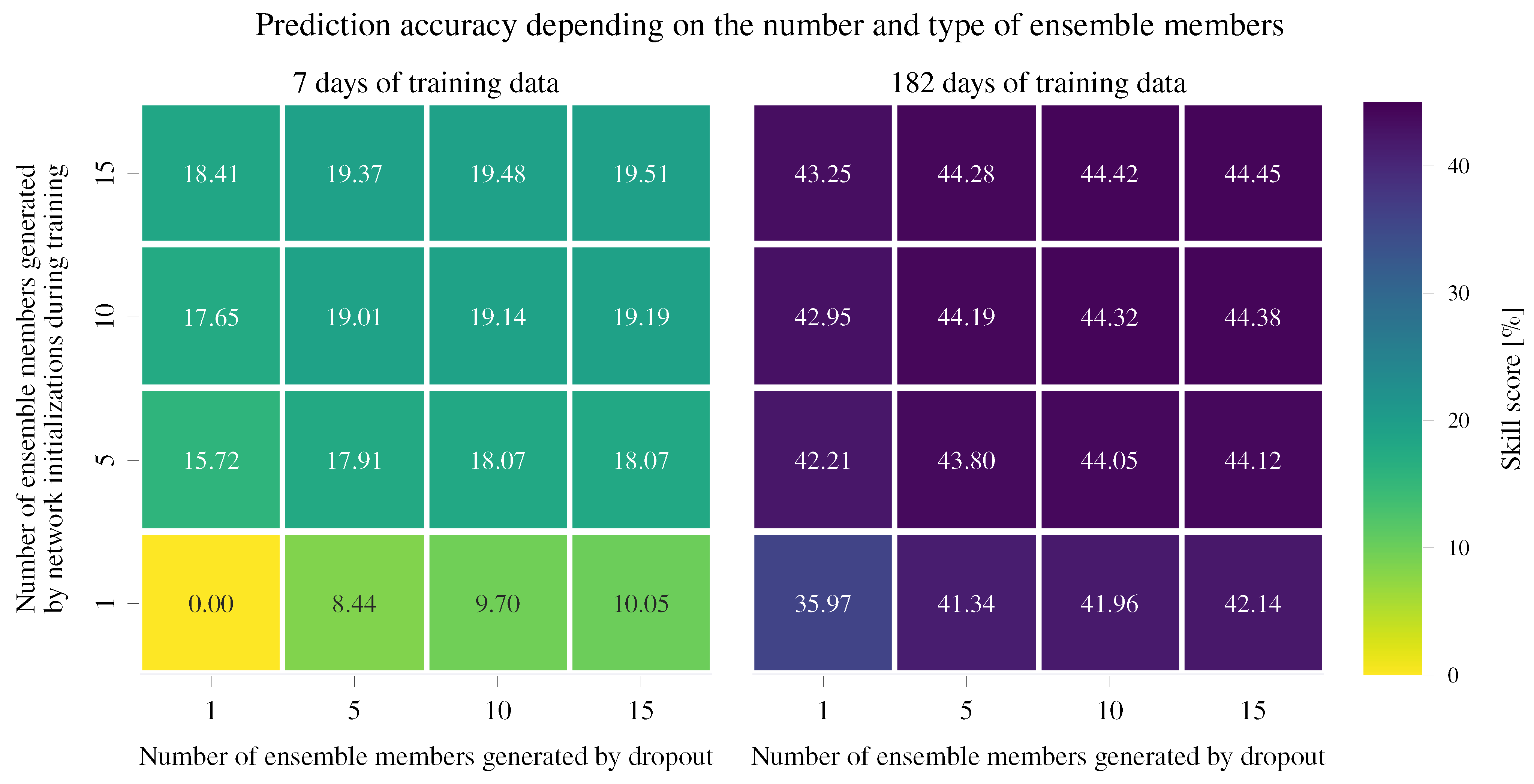
| North Bavaria (Germany) | South Bavaria (Germany) | Vienna (Austria) | |
|---|---|---|---|
| Elevation [m] | 280 | 725 | 150 |
| Annual GHI | 1.77 | 1.88 | 1.79 |
| Study period | 08/19–02/21 | 01/19–09/21 | 05/17–04/19 |
| Sample rate [min] | 15 | 15 | 15 |
| Ratio of missing days [%] | 1.3 | 4.9 | 12.2 |
| Number of samples | 50,112 | 89,280 | 55,559 |
| Solar variability | 0.188 | 0.186 | 0.195 |
| of PV panel [kW] | 1.29 | 14.584 | 14.95 |
| Installed capacity [kW] | 2.2 | 24 | 27 |
| Architecture hyperparameters | |
| Number of hidden layers | 4 |
| Number of units per hidden layer | 75 |
| Activation function | ReLU |
| Input feature information [number of samples] | |
| PV power | ∼last day [97] |
| Predicted temperature (NWP) | forecast horizon [24] |
| last 3 h [12] | |
| Predicted GHI (NWP) | forecast horizon [24] |
| ∼last day [97] | |
| Regularization techniques | |
| Dropout rate (in each hidden layer) | 0.35 |
| Weigh constraint of max norm | 2 |
| Early stopping with patience level | 150 |
| Training hyperparameters | |
| Minibatch size | 32 |
| Number of epochs | 500 |
| Optimizer | Adam |
| Validation split | 0.3 |
Disclaimer/Publisher’s Note: The statements, opinions and data contained in all publications are solely those of the individual author(s) and contributor(s) and not of MDPI and/or the editor(s). MDPI and/or the editor(s) disclaim responsibility for any injury to people or property resulting from any ideas, methods, instructions or products referred to in the content. |
© 2023 by the authors. Licensee MDPI, Basel, Switzerland. This article is an open access article distributed under the terms and conditions of the Creative Commons Attribution (CC BY) license (https://creativecommons.org/licenses/by/4.0/).
Share and Cite
Doelle, O.; Klinkenberg, N.; Amthor, A.; Ament, C. Probabilistic Intraday PV Power Forecast Using Ensembles of Deep Gaussian Mixture Density Networks. Energies 2023, 16, 646. https://doi.org/10.3390/en16020646
Doelle O, Klinkenberg N, Amthor A, Ament C. Probabilistic Intraday PV Power Forecast Using Ensembles of Deep Gaussian Mixture Density Networks. Energies. 2023; 16(2):646. https://doi.org/10.3390/en16020646
Chicago/Turabian StyleDoelle, Oliver, Nico Klinkenberg, Arvid Amthor, and Christoph Ament. 2023. "Probabilistic Intraday PV Power Forecast Using Ensembles of Deep Gaussian Mixture Density Networks" Energies 16, no. 2: 646. https://doi.org/10.3390/en16020646
APA StyleDoelle, O., Klinkenberg, N., Amthor, A., & Ament, C. (2023). Probabilistic Intraday PV Power Forecast Using Ensembles of Deep Gaussian Mixture Density Networks. Energies, 16(2), 646. https://doi.org/10.3390/en16020646






